|
[1]
|
Julien CM, Mauger A, Vijh A, et al. (2016) Lithium Batteries, Switzerland: Springer, Cham.
|
|
[2]
|
Vetter J, Novák P, Wagner MR, et al. (2005) Ageing mechanisms in lithium-ion batteries. J Power Sources 147: 269–281. doi: 10.1016/j.jpowsour.2005.01.006

|
|
[3]
|
Tröltzsch U, Kanoun O, Tränkler HR (2006) Characterizing aging effects of lithium ion batteries by impedance spectroscopy. Electrochim Acta 51: 1664–1672. doi: 10.1016/j.electacta.2005.02.148

|
|
[4]
|
Kiziltas-Yavuz N, Herklotz M, Hashem AM, et al. (2013) Synthesis, structural, magnetic and electrochemical properties of LiNi1/3Mn1/3Co1/3O2 prepared by a sol-gel method using table sugar as chelating agent. Electrochim Acta 113: 313–321. doi: 10.1016/j.electacta.2013.09.065

|
|
[5]
|
Birkl CR, Roberts MR, McTurk E, et al. (2017) Degradation diagnostics for lithium ion cells. J Power Sources 341: 373–386. doi: 10.1016/j.jpowsour.2016.12.011

|
|
[6]
|
Cabana J, Kwon BJ, Hu L (2018) Mechanisms of degradation and strategies for the stabilization of cathode–electrolyte interfaces in Li-ion batteries. Accounts Chem Res 51: 299–308. doi: 10.1021/acs.accounts.7b00482

|
|
[7]
|
Xu Z, Rahman MM, Mu L, et al. (2018) Chemomechanical behaviors of layered cathode materials in alkali metal ion batteries. J Mater Chem A 6: 21859–21884. doi: 10.1039/C8TA06875E

|
|
[8]
|
Zheng JM, Gu M, Xiao J, et al. (2014) Functioning mechanism of AlF3 coating on the Li- and Mn-rich cathode materials. Chem Mater 26: 6320–6327. doi: 10.1021/cm502071h

|
|
[9]
|
Tasaki K, Kanda K, Nakamura S, et al. (2003) Decomposition of LiPF6 and stability of PF5 in Li-ion battery electrolytes. J Electrochem Soc 150: A1628–A1636. doi: 10.1149/1.1622406

|
|
[10]
|
Myung ST, Izumi K, Komaba S, et al. (2005) Role of alumina coating on Li-Ni-Co-Mn-O particles as positive electrode material for lithium-ion batteries. Chem Mater 17: 3695–3704. doi: 10.1021/cm050566s

|
|
[11]
|
Chen Z, Qin Y, Amine K, et al. (2010) Role of surface coating on cathode materials for lithium-ion batteries. J Mater Chem 20: 7606–7612. doi: 10.1039/c0jm00154f

|
|
[12]
|
Mauger A, Julien CM (2014) Surface modifications of electrode materials for lithium-ion batteries: status and trends. Ionics 20: 751–787. doi: 10.1007/s11581-014-1131-2

|
|
[13]
|
Jin X, Xu Q, Liu H, et al. (2014) Excellent rate capability of Mg doped Li[Li0.2Ni0.13Co0.13Mn0.54]O2 cathode material for lithium-ion battery. Electrochim Acta 136: 19–26.
|
|
[14]
|
Zheng J, Wu X, Yang Y (2013) Improved electrochemical performance of Li[Li0.2Mn0.54Ni0.13Co0.13]O2 cathode material by fluorine incorporation. Electrochim Acta 105: 200–208.
|
|
[15]
|
Zhang SS (2006) A review on electrolyte additives for lithium-ion batteries. J Power Sources 162: 1379–1394. doi: 10.1016/j.jpowsour.2006.07.074

|
|
[16]
|
Li M, Zhou Y, Wu X, et al. (2018) The combined effect of CaF2 coating and La-doping on electrochemical performance of layered lithium-rich cathode material. Electrochim Acta 275: 18–24. doi: 10.1016/j.electacta.2018.04.077

|
|
[17]
|
Lu Y, Shi S, Yang F, et al. (2018) Mo-doping for improving the ZrF4 coated-Li[Li0.2Mn0.54Ni0.13Co0.13]O2 as high performance cathode materials in lithium-ion batteries. J Alloy Compd 767: 23–33.
|
|
[18]
|
Hashem AMA, Abdel-Ghany AE, Eid AE, et al. (2011) Study of the surface modification of LiNi1/3Co1/3Mn1/3O2 cathode material for lithium ion battery. J Power Sources 196: 8632–8637. doi: 10.1016/j.jpowsour.2011.06.039

|
|
[19]
|
Yang ZX, Qiao QD, Yang WS (2011) Improvement of structural and electrochemical properties of commercial LiCoO2 by coating with LaF3. Electrochim Acta 56: 4791–4796. doi: 10.1016/j.electacta.2011.03.017

|
|
[20]
|
Sun SH, Kim SB, Park YJ (2009) The effects of LaF3 coating on the electrochemical property of Li[Ni0.3Co0.4Mn0.3]O2 cathode material. B Korean Chem Soc 30: 2584–2588.
|
|
[21]
|
Xie QL, Hu ZB, Zhao CH, et al. (2015) LaF3-coated Li[Li0.2Mn0.56Ni0.16Co0.08]O2 as cathode material with improved electrochemical performance for lithium ion batteries. RSC Adv 5: 50859–50864.
|
|
[22]
|
Lee HJ, Park YJ (2013) Interface characterization of MgF2-coated LiCoO2 thin films. Solid State Ionics 230: 86–91. doi: 10.1016/j.ssi.2012.08.003

|
|
[23]
|
Shi SJ, Tu JP, Mai YJ, et al. (2012) Structure and electrochemical performance of CaF2 coated LiMn1/3Ni1/3Co1/3O2 cathode material for Li-ion batteries. Electrochim Acta 83: 105–112. doi: 10.1016/j.electacta.2012.08.029

|
|
[24]
|
Liu X, Liu J, Huang T, et al. (2013) CaF2-coated Li1.2Mn0.54Ni0.13Co0.13O2 as cathode materials for Li-ion batteries. Electrochim Acta 109: 52–58.
|
|
[25]
|
Zhang X, Yang Y, Sun S, et al. (2016) Multifunctional ZrF4 nanocoating for improving lithium storage performances in layered Li[Li0.2Ni0.17Co0.07Mn0.56]O2. Solid State Ionics 284: 7–13.
|
|
[26]
|
Li JG, Wang L, Zhang Q, et al. (2009) Electrochemical performance of SrF2-coated LiMn1/3Ni1/3Co1/3O2 cathode materials for Li-ion batteries. J Power Sources 190: 149–153. doi: 10.1016/j.jpowsour.2008.08.011

|
|
[27]
|
Liu BL, Zhang Z, Wan J, et al. (2017) Improved electrochemical properties of YF3-coated Li1.2Mn0.54Ni0.13Co0.13O2 as cathode for Li-ion batteries. Ionics 23: 1365–1374.
|
|
[28]
|
Sun YK, Cho SW, Myung ST, et al. (2007) Effect of AlF3 coating amount on high voltage cycling performance of LiCoO2. Electrochim Acta 53: 1013–1019. doi: 10.1016/j.electacta.2007.08.032

|
|
[29]
|
Wang Z, Wang Z, Guo H, et al. (2014) Enhanced high-voltage electrochemical performance of LiCoO2 coated with ZrOxFy. Mater Lett 123: 93–96. doi: 10.1016/j.matlet.2014.03.021

|
|
[30]
|
Lee KS, Myung ST, Amine K, et al. (2009) Dual functioned BiOF-coated Li[Li0.1Al0.05Mn1.85]O4 for lithium batteries. J Mater Chem 19: 1995–2005.
|
|
[31]
|
Hao Y, Yand F, Luo D, et al. (2018) Improved electrochemical performances of yttrium oxyfluoride-coated Li[Li0.2Mn0.54Ni0.13Co0.13]O2 for lithium ion batteries. J Energy Chem 27: 1239–1246.
|
|
[32]
|
Bai Y, Jiang K, Sun S, et al. (2014) Performance improvement of LiCoO2 by MgF2 surface modification and mechanism exploration. Electrochim Acta 134: 347–354. doi: 10.1016/j.electacta.2014.04.155

|
|
[33]
|
Shi SJ, Tu JP, Tang YY, et al. (2013) Enhanced electrochemical performance of LiF-modified LiMn1/3Ni1/3Co1/3O2 cathode materials for Li-ion batteries. J Power Sources 225: 338–346. doi: 10.1016/j.jpowsour.2012.10.065

|
|
[34]
|
Chen Q, Wang Y, Zhang T, et al. (2012) Electrochemical performance of LaF3-coated LiMn2O4 cathode materials for lithium ion batteries. Electrochim Acta 83: 65–72. doi: 10.1016/j.electacta.2012.08.025

|
|
[35]
|
Amatucci GG, Pereira N (2007) Fluoride based electrode materials for advanced energy storage devices. J Fluorine Chem 128: 243–262. doi: 10.1016/j.jfluchem.2006.11.016

|
|
[36]
|
Cabana J, Monconduit L, Larcher D, et al. (2010) Beyond intercalation-based Li-ion batteries: The state of the art and challenges of electrode materials reacting through conversion reactions. Adv Mater 22: E170–E192. doi: 10.1002/adma.201000717

|
|
[37]
|
Badway F, Cosandey F, Pereira N, et al. (2003) Carbon metal fluoride nanocomposites: High-capacity reversible metal fluoride conversion materials as rechargeable positive electrodes for Li batteries. J Electrochem Soc 150: A1318–A1327. doi: 10.1149/1.1602454

|
|
[38]
|
Bervas M, Badway F, Klein LC, et al. (2005) Bismuth fluoride nanocomposite as a positive electrode material for rechargeable lithium batteries. Electrochem Solid-State Lett 8: A179–A183. doi: 10.1149/1.1861040

|
|
[39]
|
Owen N, Zhang Q (2017) Investigations of aluminum fluoride as a new cathode material for lithium-ion batteries. J Appl Electrochem 47: 417–431. doi: 10.1007/s10800-017-1049-2

|
|
[40]
|
Le Bail A, Calvayrac F (2006) Hypothetical AlF3 crystal structures. J Solid State Chem 179: 3159–3166.
|
|
[41]
|
Navarro JL, Albanesi E, Vidal RA, et al. (2016) A study on the structural, electronic and optical properties of the α-AlF3 compound. Mater Res Bull 83: 615–622. doi: 10.1016/j.materresbull.2016.07.007

|
|
[42]
|
Bridou F, Cuniot-Ponsard M, Desvignes JM, et al. (2010) Experimental determination of optical constants of MgF2 and AlF3 thin films in the vacuum ultra-violet wavelength region (60–124 nm), and its application to optical designs. Opt Commun 283: 1351–1358. doi: 10.1016/j.optcom.2009.11.062

|
|
[43]
|
Myung ST, Lee KS, Yoon CS, et al. (2010) Effect of AlF3 coating on thermal behavior of chemically delithiated Li0.35[Ni1/3Co1/3Mn1/3]O2. J Phys Chem C 114: 4710–4718.
|
|
[44]
|
Kemnitz E, Menz DH (1998) Fluorinated metal oxides and metal fluorides as heterogeneous catalysts. Prog Solid State Ch 26: 97–153. doi: 10.1016/S0079-6786(98)00003-X

|
|
[45]
|
Sun YK, Lee MJ, Yoon CS, et al. (2012) The role of AlF3 coatings in improving electrochemical cycling of Li-enriched nickel-manganese oxide electrodes for Li-ion batteries. Adv Mater 24: 1192–1196. doi: 10.1002/adma.201104106

|
|
[46]
|
Kanamura K, Okagawa T, Takehara ZI (1995) Electrochemical oxidation of propylene carbonate (containing various salts) on aluminum electrodes. J Power Sources 57: 119–123. doi: 10.1016/0378-7753(95)02265-1

|
|
[47]
|
Morita M, Shibata T, Yoshimoto N, et al. (2002) Anodic behavior of aluminum in organic solutions with different electrolytic salts for lithium ion batteries. Electrochim Acta 47: 2787–2793. doi: 10.1016/S0013-4686(02)00164-0

|
|
[48]
|
Ma T, Xu GL, Li Y, et al. (2017) Revisiting the corrosion of the aluminum current collector in lithium-ion batteries. J Phys Chem Lett 8: 1072–1077. doi: 10.1021/acs.jpclett.6b02933

|
|
[49]
|
Kawamura T, Tanaka T, Egashira M, et al. (2005) Methyl difluoroacetate inhibits corrosion of aluminum cathode current collector for lithium ion cells. Electrochem Solid-State Lett 8: A459–A463. doi: 10.1149/1.1993367

|
|
[50]
|
Hennessy J, Jewell AD, Balasubramanian K, et al. (2016) Ultraviolet optical properties of aluminum fluoride thin films deposited by atomic layer deposition. J Vac Sci Technol A 34: 01A120.
|
|
[51]
|
Lee Y, DuMont JW, Cavanagh AS, et al. (2015) Atomic layer deposition of AlF3 using trimethylaluminum and hydrogen fluoride. J Phys Chem C 119: 14185–14194. doi: 10.1021/acs.jpcc.5b02625

|
|
[52]
|
Mane AU, Elam JW, Park JS, et al. (2016) Metal fluoride passivation coatings prepared by atomic layer deposition on LiCoO2 for Li-ion batteries. US Patent 2016/0260962A1.
|
|
[53]
|
Zhou Y, Lee Y, Sun H, et al. (2017) Coating solution for high-voltage cathode: AlF3 atomic layer deposition for freestanding LiCoO2 electrodes with high energy density and excellent flexibility. ACS Appl Mater Inter 9: 9614–9619. doi: 10.1021/acsami.6b15628

|
|
[54]
|
Pang S, Wang Y, Chen T, et al. (2016) The effect of AlF3 modification on the physicochemical and electrochemical properties of Li-rich layered oxide. Ceram Int 42: 5397–5402. doi: 10.1016/j.ceramint.2015.12.076

|
|
[55]
|
Jackson DHK (2016) Optimizing AlF3 atomic layer deposition using trimethylaluminum and TaF5: Application to high voltage Li-ion battery cathodes. J Vac Sci Technol A 34: 031503. doi: 10.1116/1.4943385

|
|
[56]
|
Lee HJ, Kim SB, Park YJ (2012) Enhanced electrochemical properties of fluoride-coated LiCoO2 thin films. Nanoscale Res Lett 7: 16. doi: 10.1186/1556-276X-7-16

|
|
[57]
|
Hao S, Wolverton C (2013) Lithium transport in amorphous Al2O3 and AlF3 for discovery of battery coatings. J Phys Chem C 117: 8009–8013. doi: 10.1021/jp311982d

|
|
[58]
|
Jung SC, Han YK (2013) How do Li atoms pass through the Al2O3 coating layer during lithiation in Li-ion batteries? J Phys Chem Lett 4: 2681–2685. doi: 10.1021/jz401231e

|
|
[59]
|
Xu S, Jacobs RM, Nguyen HM, et al. (2015) Lithium transport through lithium-ion battery cathode coatings. J Mater Chem A 3: 17248–17272. doi: 10.1039/C5TA01664A

|
|
[60]
|
Riley LA, Van Atta S, Cavanagh AS, et al. (2011) Electrochemical effects of ALD surface modification on combustion synthesized LiNi1/3Mn1/3Co1/3O2 as a layered-cathode material. J Power Sources 196: 3317–3324. doi: 10.1016/j.jpowsour.2010.11.124

|
|
[61]
|
Cheng HM, Wang FM, Chu JP, et al. (2012) Enhanced cyclability in lithium ion batteries: resulting from atomic layer deposition of Al2O3 or TiO2 on LiCoO2 electrodes. J Phys Chem C 116: 7629–7637.
|
|
[62]
|
Li X, Liu J, Meng X, et al. (2014) Significant impact on cathode performance of lithium-ion batteries by precisely controlled metal oxide nanocoatings via atomic layer deposition. J Power Sources 247: 57–69. doi: 10.1016/j.jpowsour.2013.08.042

|
|
[63]
|
Kim JH, Park MH, Song JH, et al. (2012) Effect of aluminum fluoride coating on the electrochemical and thermal properties of 0.5Li2MnO3·0.5LiNi0.5Co0.2Mn0.3O2 composite material. J Alloy Compd 517: 20–25.
|
|
[64]
|
Oi T, Miyauchi K, Uehara K (1982) Electrochromism of WO3/LiAlF4/LiIn thin-film overlayers. J Appl Phys 53: 1823. doi: 10.1063/1.330597

|
|
[65]
|
Stechert TR, Rushton MJD, Grimes RW, et al. (2012) Predicted structure, thermo-mechanical properties and Li ion transport in LiAlF4 glass. J Non-Cryst Solids 358: 1917–1923. doi: 10.1016/j.jnoncrysol.2012.05.044

|
|
[66]
|
Xie J, Sendek AD, Cubuk ED, et al. (2017) Atomic layer deposition of stable LiAlF4 lithium ion conductive interfacial layer for stable cathode cycling. ACS Nano 11: 7019–7027. doi: 10.1021/acsnano.7b02561

|
|
[67]
|
Oi T (1984) Ionic conductivity of LiF thin films containing di- and trivalent metal fluorides. Mater Res Bull 19: 451–457. doi: 10.1016/0025-5408(84)90105-3

|
|
[68]
|
Goodenough JB, Kim Y (2010) Challenges for rechargeable Li batteries. Chem Mater 22: 587–603.
|
|
[69]
|
Goodenough JB, Park KS (2013) The Li-ion rechargeable battery: A perspective. J Am Chem Soc 135: 1167–1176. doi: 10.1021/ja3091438

|
|
[70]
|
Goodenough JB (2014) Electrochemical energy storage in a sustainable modern society. Energ Environ Sci 7: 14–18. doi: 10.1039/C3EE42613K

|
|
[71]
|
Sun YK, Han JM, Myung ST, et al. (2006) Significant improvement of high voltage cycling behavior AlF3-coated LiCoO2 cathode. Electrochem Commun 8: 821–826. doi: 10.1016/j.elecom.2006.03.040

|
|
[72]
|
Sun YK, Yoon CS, Myung ST, et al. (2009) Role of AlF3 coating on LiCoO2 particles during cycling to cutoff voltage above 4.5 V. J Electrochem Soc 156: A1005–A1010. doi: 10.1149/1.3236501

|
|
[73]
|
Aboulaich A, Ouzaoult K, Faqir H, et al. (2016) Improving thermal and electrochemical performances of LiCoO2 cathode at high cut-off charge potentials by MF3 (M = Ce, Al) coating. Mater Res Bull 73: 362–368. doi: 10.1016/j.materresbull.2015.09.020

|
|
[74]
|
Sun YK, Park BC, Yashiro H (2008) Improvement of the electrochemical properties of Li[Ni0.5Mn0.5]O2 by AlF3 coating. J Electrochem Soc 155: A705–A710.
|
|
[75]
|
Abdel-Ghany A, El-Tawil RS, Hashem AM, et al. (2019) Improved electrochemical performance of LiNi0.5Mn0.5O2 by Li-enrichment and AlF3 coating. Materialia 5: 100207.
|
|
[76]
|
Woo SU, Yoon CS, Amine K, et al. (2007) Significant improvement of electrochemical performance of AlF3-coated Li[Ni0.8Co0.1Mn0.1]O2 cathode materials. J Electrochem Soc 154: A1005–A1009.
|
|
[77]
|
Sun YK, Cho SW, Lee SW, et al. (2007) AlF3-coating to improve high voltage cycling performance of Li[Ni1 ∕ 3Co1 ∕ 3Mn1 ∕ 3]O2 cathode materials for lithium secondary batteries. J Electrochem Soc 154: A168–A172. doi: 10.1149/1.2422890

|
|
[78]
|
Lee KS, Myung ST, Kim DW, et al. (2011) AlF3-coated LiCoO2 and Li[Ni1/3Co1/3Mn1/3]O2 blend composite cathode for lithium ion batteries. J Power Sources 196: 6974–6977. doi: 10.1016/j.jpowsour.2010.11.014

|
|
[79]
|
Park BC, Kim HB, Myung ST, et al. (2008) Improvement of structural and electrochemical properties of AlF3-coated Li[Ni1/3Co1/3Mn1/3]O2 cathode materials on high voltage region. J Power Sources 178: 826–831. doi: 10.1016/j.jpowsour.2007.08.034

|
|
[80]
|
Wang HY, Tang AD, Huang KL, et al. (2010) Uniform AlF3 thin layer to improve rate capability of LiNi1/3Co1/3 Mn1/3O2 material for Li-ion batteries. T Nonferr Metal Soc 20: 803–808.
|
|
[81]
|
Shi SJ, Tu JP, Tang YY, et al. (2013) Enhanced electrochemical performance of LiF-modified LiMn1/3Ni1/3Co1/3O2 cathode materials for Li-ion batteries. J Power Sources 225: 338–346. doi: 10.1016/j.jpowsour.2012.10.065

|
|
[82]
|
Lin H, Yang Y (2009) Structural characterization and electrochemical performance of AlF3-coated LiNi0.45Mn0.45Co0.10O2 as cathode materials for lithium ion batteries. Acta Chim Sinica 67: 104–108.
|
|
[83]
|
Myung ST, Lee KS, Yoon CS, et al. (2010) Effect of AlF3 coating on thermal behavior of chemically delithiated Li0.35[Ni1/3Co1/3Mn1/3]O2. J Phys Chem C 114: 4710–4718.
|
|
[84]
|
Song HG, Park YJ (2012) LiLaPO4-coated Li[Ni0.5Co0.2Mn0.3]O2 and AlF3-coated Li[Ni0.5Co0.2Mn0.3]O2 blend composite for lithium ion batteries. Mater Res Bull 47: 2843–2846.
|
|
[85]
|
Yang K, Fan LZ, Guo J, et al. (2012) Significant improvement of electrochemical properties of AlF3-coated LiNi0.5Co0.2Mn0.3O2 cathode materials. Electrochim Acta 63: 363–368.
|
|
[86]
|
Amalraj F, Talianker M, Markovsky B, et al. (2013) Studies of Li and Mn-rich Lix[MnNiCo]O2 electrodes: electrochemical performance, structure, and the effect of the aluminum fluoride coating. J Electrochem Soc 160: A2220–A2233.
|
|
[87]
|
Sun S, Yin Y, Wan N, et al. (2015) AlF3 surface‐coated Li[Li0.2Ni0.17Co0.07Mn0.56]O2 nanoparticles with superior electrochemical performance for lithium‐ion batteries. ChemSusChem 8: 2544–2550.
|
|
[88]
|
Xiao QC, Sun KL, Zhang HL, et al. (2014) High performance Li1.2(Mn0.54Co0.13Ni0.13)O2 with AlF3/carbon hybrid shell for lithium ion batteries. Mater Technol 29: A70–A76.
|
|
[89]
|
Deng H, Belharouak I, Yoon CS, et al. (2010) High temperature performance of surface-treated Li1.1(Ni0.15Co0.1Mn0.55)O1.95 layered oxide. J Electrochem Soc 157: A1035–A1039.
|
|
[90]
|
Zhao T, Chen S, Chen R, et al. (2014) The positive roles of integrated layered-spinel structures combined with nanocoating in low-cost Li-rich cathode Li[Li0.2Fe0.1Ni0.15Mn0.55]O2 for lithium-ion batteries. ACS Appl Mater Inter 6: 21711–21720.
|
|
[91]
|
Li GR, Feng X, Ding Y, et al. (2012) AlF3-coated Li(Li0.17Ni0.25Mn0.58)O2 as cathode material for Li-ion batteries. Electrochim Acta 78: 308–315.
|
|
[92]
|
Ding J, Lu Z, Wu M, et al. (2017) Preparation and performance characterization of AlF3 as interface stabilizer coated Li1.24Ni0.12Co0.12Mn0.56O2 cathode for lithium-ion batteries. Appl Surf Sci 406: 21–29.
|
|
[93]
|
Rosina KJ, Jiang M, Zeng D, et al. (2012) Structure of aluminum fluoride coated Li[Li1/9Ni1/3Mn5/9]O2 cathodes for secondary lithium-ion batteries. J Mater Chem 22: 20602–20610. doi: 10.1039/c2jm34114j

|
|
[94]
|
Wang XY, Ye XH, Zhi XK, et al. (2013) Effects of AlF3 coating on the electrochemical performance of Li1.2Mn0.52Ni0.2Co0.08O2 cathode materials. Chinese J Inorg Chem 29: 774–778.
|
|
[95]
|
Li Y, Liu KY, Lü MY, et al. (2014) Synthesis, characterization and electrochemical performance of AlF3-coated Li1.2(Mn0.54Ni0.16Co0.08)O2 as cathode for Li-ion battery. T Nonferr Metal Soc 24: 3534–3540.
|
|
[96]
|
Park K, Park JH, Hong SG, et al. (2016) Induced AlF3 segregation for the generation of reciprocal Al2O3 and LiF coating layer on self-generated LiMn2O4 surface of over-lithiated oxide based Li-ion battery. Electrochim Acta 222: 830–837. doi: 10.1016/j.electacta.2016.11.044

|
|
[97]
|
Zhao S, Sun B, Yan K, et al. (2018) Aegis of lithium-rich cathode materials via heterostructured LiAlF4 coating for high-performance lithium-ion batteries. ACS Appl Mater Inter 10: 33260–33268. doi: 10.1021/acsami.8b11471

|
|
[98]
|
Chen D, Tu W, Chen M, et al. (2016) Synthesis and performances of Li-rich@AlF3@graphene as cathode of lithium ion battery. Electrochim Acta 193: 45–53. doi: 10.1016/j.electacta.2016.02.043

|
|
[99]
|
Zhu L, Liu Y, Wu W, et al. (2015) Surface fluorinated LiNi0.8Co0.15Al0.05O2 as a positive electrode material for lithium ion batteries. J Mater Chem A 3: 151456–15162.
|
|
[100]
|
Kim HB, Park BC, Myung ST, et al. (2008) Electrochemical and thermal characterization of AlF3-coated Li[Ni0.8Co0.15Al0.05]O2 cathode in lithium-ion cells. J Power Sources 179: 347–350.
|
|
[101]
|
Park BC, Kim HB, Bang HJ, et al. (2008) Improvement of electrochemical performance of Li[Ni0.8Co0.15Al0.05]O2 cathode materials by AlF3 coating at various temperatures. Ind Eng Chem Res 47: 3876–3882.
|
|
[102]
|
Zhang L, Luo F, Wang J, et al. (2014) Surface coating and electrochemical properties of LiNi0.8Co0.15Al0.05O2 cathode in lithium-ion cells. Adv Mater Res 1058: 317–320.
|
|
[103]
|
Lee SH, Yoon CS, Amine K, et al. (2013) Improvement of long-term cycling performance of Li[Ni0.8Co0.15Al0.05]O2 by AlF3 coating. J Power Sources 234: 201–207.
|
|
[104]
|
Lee DJ, Lee KS, Myung ST, et al. (2011) Improvement of electrochemical properties of Li1.1Mn1.85Al0.05O4 achieved by an AlF3 coating. J Power Sources 196: 1353–1357.
|
|
[105]
|
Liu H, Tang D (2009) The effect of nanolayer AlF3 coating on LiMn2O4 cycle life in high temperature for lithium secondary batteries. Russ J Electrochem 45: 762–764. doi: 10.1134/S1023193509070088

|
|
[106]
|
Tron A, Park YD, Mun J (2016) AlF3-coated LiMn2O4 as cathode material for aqueous rechargeable lithium battery with improved cycling stability. J Power Sources 325: 360–364. doi: 10.1016/j.jpowsour.2016.06.049

|
|
[107]
|
Liu Y, Lv J, Fei Y, et al. (2013) Improvement of storage performance of LiMn2O4/graphite battery with AlF3-coated LiMn2O4. Ionics 19: 1241–1246. doi: 10.1007/s11581-013-0853-x

|
|
[108]
|
Wang MS, Wang J, Zhang J, et al. (2015) Improving electrochemical performance of spherical LiMn2O4 cathode materials for lithium ion batteries by Al-F codoping and AlF3 surface coating. Ionics 21: 27–35. doi: 10.1007/s11581-014-1164-6

|
|
[109]
|
Zhu Z, Cai F, Yu J (2016) Improvement of electrochemical performance for AlF3-coated Li1.3Mn4/6Ni1/6Co1/6O2.40 cathode materials for Li-ion batteries. Ionics 22: 1353–1359.
|
|
[110]
|
Wu Q, Yin Y, Sun S, et al. (2015) Novel AlF3 surface modified spinel LiMn1.5Ni0.5O4 for lithium-ion batteries: performance characterization and mechanism exploration. Electrochim Acta 158: 73–80.
|
|
[111]
|
Li J, Zhang Y, Li J, et al. (2011) AlF3 coating of LiNi0.5Mn1.5O4 for high-performance Li-ion batteries. Ionics 17: 671–675.
|
|
[112]
|
Ke X, Zhao Z, Liu J, et al. (2016) Spinel oxide cathode material for high power lithium ion batteries for electrical vehicles. Energy Procedia 88: 689–692. doi: 10.1016/j.egypro.2016.06.099

|
|
[113]
|
Ochsner A, Murch GE, Shokuhfar A, et al. (2009) Improvement of the electrochemical properties in nano-sized Al2O3 and AlF3-coated LiFePO4 cathode materials. Defect Diffusion Forum 297–301: 906–911.
|
|
[114]
|
Song GM, Wu Y, Liu G, et al. (2009) Influence of AlF3 coating on the electrochemical properties of LiFePO4/graphite Li-ion batteries. J Alloy Compd 487: 214–217. doi: 10.1016/j.jallcom.2009.06.153

|
|
[115]
|
Tron A, Jo YN, Oh SH, et al. (2017) Surface modification of the LiFePO4 cathode for the aqueous rechargeable lithium ion battery. ACS Appl Mater Inter 9: 12391–12399. doi: 10.1021/acsami.6b16675

|
|
[116]
|
Wang Y, Qiu J, Yu Z, et al. (2018) AlF3-modified LiCoPO4 for an advanced cathode towards high energy lithium-ion battery. Ceram Int 44: 1312–1320. doi: 10.1016/j.ceramint.2017.08.084

|
|
[117]
|
Ding F, Xu W, Choi D, et al. (2012) Enhanced performance of graphite anode materials by AlF3 coating for lithium-ion batteries. J Mater Chem 22: 12745–12751. doi: 10.1039/c2jm31015e

|
|
[118]
|
Xu W, Chen X, Wang W, et al. (2013) Simply AlF3-treated Li4Ti5O12 composite anode materials for stable and ultrahigh power lithium-ion batteries. J Power Sources 236: 169–174. doi: 10.1016/j.jpowsour.2013.02.055

|
|
[119]
|
Li W, Li X, Chen M, et al. (2014) AlF3 modification to suppress the gas generation of Li4Ti5O12 composite anode battery. Electrochim Acta 139: 104–110. doi: 10.1016/j.electacta.2014.07.017

|
|
[120]
|
Liang G, Pillai AS, Peterson VK, et al. (2018) Effect of AlF3-coated Li4Ti5O12 on the performance and function of the LiNi0.5Mn1.5O4||Li4Ti5O12 full battery-An in operando neutron powder diffraction study. Front Energy Res 6: 89.
|
|
[121]
|
Kim JW, Kim DH, Oh DY, et al. (2015) Surface chemistry of LiNi0.5Mn1.5O4 particles coated by Al2O3 using atomic layer deposition for lithium-ion batteries. J Power Sources 274: 1254–1262.
|
|
[122]
|
Han JM, Myung ST, Cho SW, et al. (2006) Significant of AlF3-coated LiCoO2 cathode in high voltage cycling. Extended Abstract of the 210th ECS Meeting, Cancun, Mexico.
|
|
[123]
|
Makimura Y, Ohzuku T (2003) Lithium insertion material of LiNi1/2Mn1/2O2 for advanced lithium-ion batteries. J Power Sources 119–121: 156–160.
|
|
[124]
|
Lin H, Zheng J, Yang Y (2010) The effects of quenching treatment and AlF3 coating on LiNi0.5Mn0.5O2 cathode materials for lithium-ion battery. Mater Chem Phys 119: 519–523.
|
|
[125]
|
Amalraj F, Sclar H, Shilina Y, et al. (2018) Horizons for Li-ion batteries relevant to electro-mobility: high-specific-energy cathodes and chemically active separators. Adv Mater 30: 1801348. doi: 10.1002/adma.201801348

|
|
[126]
|
Zhao F, Mu D, Hou X, et al. (2015) Co-effect of AlF3 and MgF2 on the electrochemical performance of LiNi0.5Mn0.3Co0.2O2 cathode material under high voltage. Adv Mater Res 1088: 327–331.
|
|
[127]
|
Nayak PK, Erickson EM, Schipper F, et al. (2018) Review on challenges and recent advances in the electrochemical performance of high capacity Li- and Mn-rich cathode materials for Li-ion batteries. Adv Energy Mater 8: 1702397. doi: 10.1002/aenm.201702397

|
|
[128]
|
Schipper F, Nayak PK, Erickson EM, et al. (2017) Studies of cathode materials for lithium-ion batteries: recent progress and new challenges. Inorganics 5: 32. doi: 10.3390/inorganics5020032

|
|
[129]
|
Li H, Cormier M, Zhang N, et al. (2019) Is cobalt needed in Ni-rich positive electrode materials for lithium ion batteries? J Electrochem Soc 166: A429–A439. doi: 10.1149/2.1381902jes

|
|
[130]
|
Park J, Seo JH, Plett G, et al. (1993) Numerical simulation of the effect of the dissolution of LiMn2O4 particles on Li-ion battery performance. Electrochem Solid-State Lett 14: A14–A18.
|
|
[131]
|
Oh RG, Hong JE, Yang WG, et al. (2015) Effects of Al2O3 and AlF3 coating on the electrochemical performance of Li3V2(PO4)3/C cathode material in lithium ion batteries. Solid State Ionics 283: 131–136. doi: 10.1016/j.ssi.2015.10.004

|
|
[132]
|
Hovington P, Lagacé M, Guerfi A, et al. (2015) New lithium metal polymer solid state battery for an ultrahigh energy: nano C-LiFePO4 versus nano Li1.2V3O8. Nano Lett 15: 2671–2678.
|
|
[133]
|
Wang H, Yu Y, Jin G, et al. (2013) AlF3 coated LiV3O8 nanosheets with significantly improved cycling stability as cathode material for Li-ion battery. Solid State Ionics 236: 37–42. doi: 10.1016/j.ssi.2013.01.021

|
|
[134]
|
Julien CM, Mauger A (2018) In situ Raman analyses of electrode materials for Li-ion batteries. AIMS Mater Sci 5: 650–698. doi: 10.3934/matersci.2018.4.650

|
|
[135]
|
Julien CM (2000) 4-volt cathode materials for rechargeable lithium batteries wet-chemistry synthesis, structure and electrochemistry. Ionics 6: 30–46. doi: 10.1007/BF02375545

|
|
[136]
|
Julien CM, Massot M (2003) Lattice vibrations of materials for lithium rechargeable batteries III. Lithium manganese oxides. Mat Sci Eng B-Adv 100: 69–78.
|
|
[137]
|
Gross U, Rüdiger S, Kemnitz E, et al. (2007) Vibrational analysis study of aluminum trifluoride phases. J Phys Chem A 111: 5813–5819. doi: 10.1021/jp072388r

|
|
[138]
|
Boulard B, Jacoboni C, Rousseau M (1989) Raman spectroscopy vibrational analysis of octahedrally coordinated fluorides: Application to transition metal fluoride glasses. J Solid State Chem 80: 17–31. doi: 10.1016/0022-4596(89)90027-3

|
|
[139]
|
Makarowicz A, Bailey CL, Weiher N, et al. (2009) Electronic structure of Lewis acid sites on high surface area aluminium fluorides: a combined XPS and ab initio investigation. Phys Chem Chem Phys 11: 5664–5673. doi: 10.1039/b821484k

|
|
[140]
|
Tatara R, Karayaylali P, Yu Y, et al. (2019) The effect of electrode-electrolyte interface on the electrochemical impedance spectra for positive electrode in Li-ion battery. J Electrochem Soc 166: A5090–A5098. doi: 10.1149/2.0121903jes

|
|
[141]
|
Kendig M, Scully J (1990) Basic aspects of electrochemical impedance application for the life prediction of organic coatings on metals. Corrosion 46: 22–29. doi: 10.5006/1.3585061

|
|
[142]
|
Fletcher S (1994) Tables of degenerate electrical networks for use in the equivalent-circuit analysis of electrochemical systems. J Electrochem Soc 141: 1823–1826. doi: 10.1149/1.2055011

|
|
[143]
|
Zheng JM, Zhang ZR, Wu XB, et al. (2008) The effects of AlF3 coating on the performance of Li[Li0.2Mn0.54Ni0.13Co0.13]O2 positive electrode material for lithium-ion battery. J Electrochem Soc 155: A775–A782.
|
|
[144]
|
Li D, Sasaki Y, Kobayakawa K, et al. (2006) Preparation and electrochemical characteristics of LiNi1/3Mn1/3Co1/3O2 coated with metal oxides coating. J Power Sources 160: 1342–1348. doi: 10.1016/j.jpowsour.2006.02.080

|
|
[145]
|
Kang SH, Amine K (2007) Layered cathode materials for lithium ion rechargeable batteries. US Patent 7,205,072B2.
|
|
[146]
|
Gallagher KG, Nelson PA, Dees DW (2011) Simplified calculation of the area specific impedance for battery design. J Power Sources 196: 2289–2297. doi: 10.1016/j.jpowsour.2010.10.020

|
|
[147]
|
Belharouak I, Sun YK, Liu J, et al. (2003) Li(Ni1/3Co1/3Mn1/3)O2 as a suitable cathode for high power applications. J Power Sources 123: 247–252. doi: 10.1016/S0378-7753(03)00529-9

|
|
[148]
|
Son JT (2008) Improvement of electrochemical properties of surface modified Li1.05Ni0.35Co0.25Mn0.4O2 cathode material for lithium secondary battery. B Korean Chem Soc 29: 1695–1698.
|
|
[149]
|
Klett M, Gilbert JA, Pupek KZ, et al. (2017) Layered oxide, graphite and silicon-graphite electrodes for lithium-ion cells: Effect of electrolyte composition and cycling windows. J Electrochem Soc 164: A6095–A6102. doi: 10.1149/2.0131701jes

|
|
[150]
|
Shim J, Striebel KA (2003) Characterization of high-power lithium-ion cells during constant current cycling: Part I. Cycle performance and electrochemical diagnostics. J Power Sources 122: 188–194.
|
|
[151]
|
Nakura K, Ariyoshi K, Ogaki F, et al. (2014) Characterization of lithium insertion electrodes: a method to measure area-specific impedance of single electrode. J Electrochem Soc 161: A841–A846. doi: 10.1149/2.090405jes

|
|
[152]
|
Mauger A, Julien CM (2017) Critical review on lithium-ion batteries: are they safe? Sustainable? Ionics 23: 1933–1947.
|
|
[153]
|
Wang MS, Wang J, Zhang J, et al. (2015) Improving electrochemical performance of spherical LiMn2O4 cathode materials for lithium ion batteries by Al-F codoping and AlF3 surface coating. Ionics 21: 27–35. doi: 10.1007/s11581-014-1164-6

|
|
[154]
|
Tron A, Kang H, Kim J, et al. (2018) Electrochemical performance of AlF3-coated LiV3O8 for aqueous rechargeable lithium-ion batteries. J Electrochem Sci Te 9: 60–68. doi: 10.33961/JECST.2018.9.1.60

|











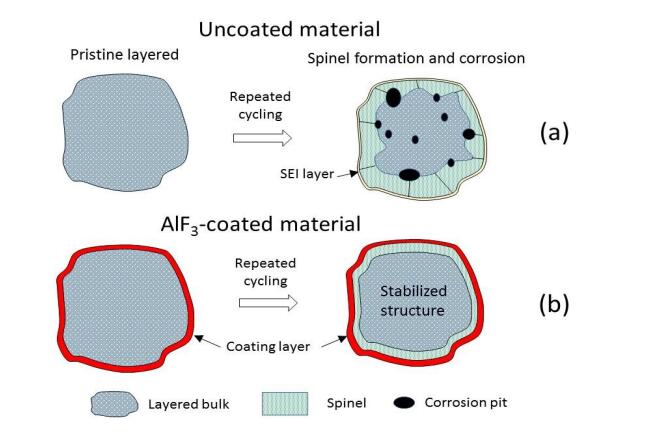
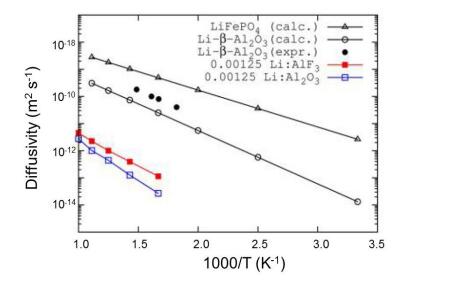
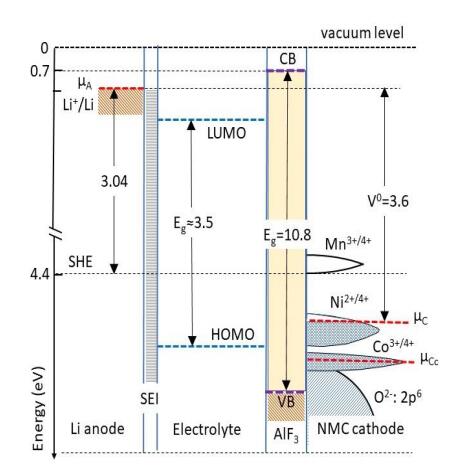
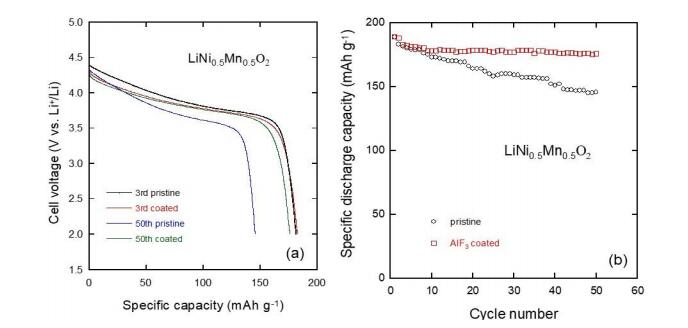
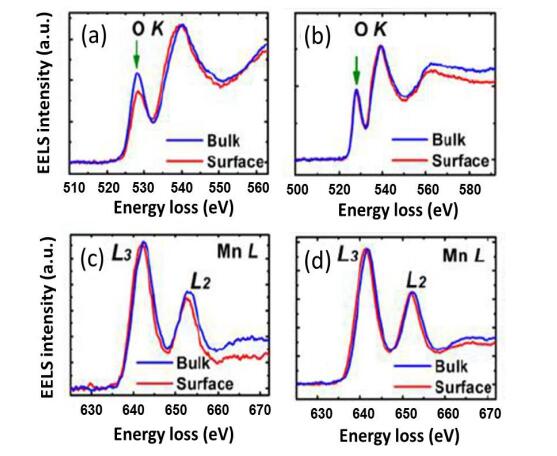
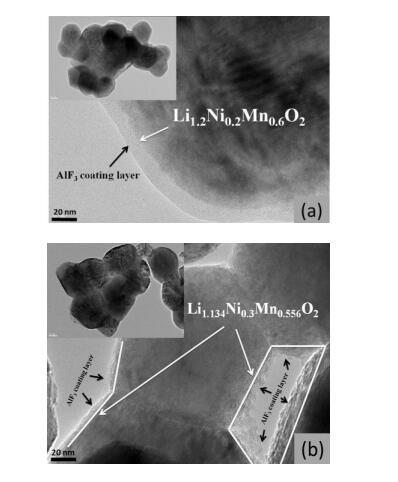
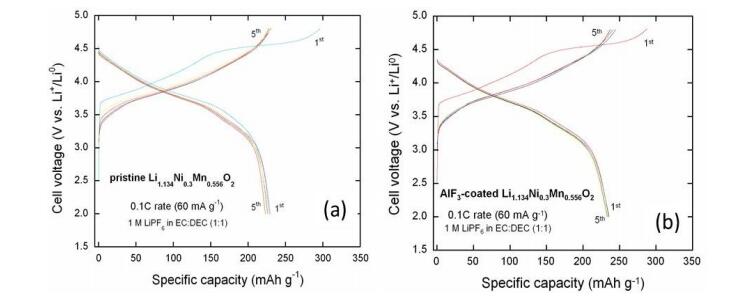
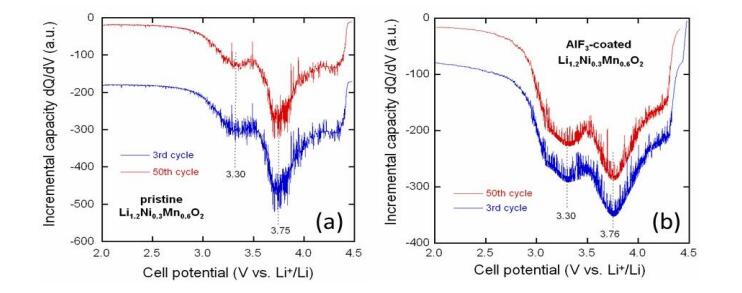
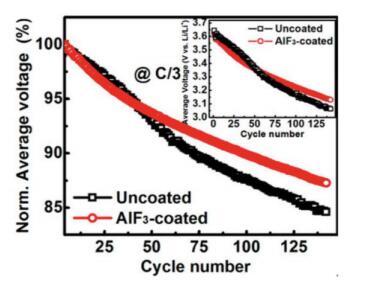
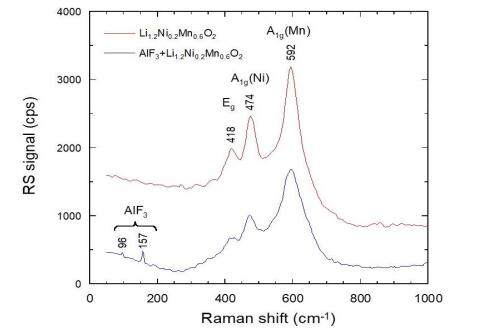
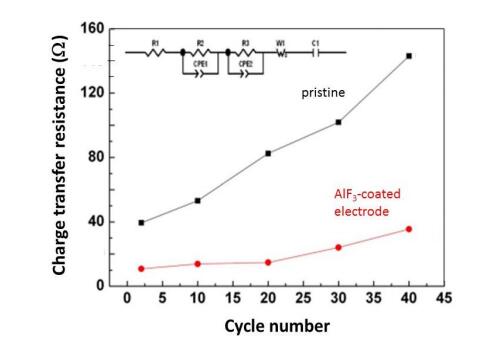
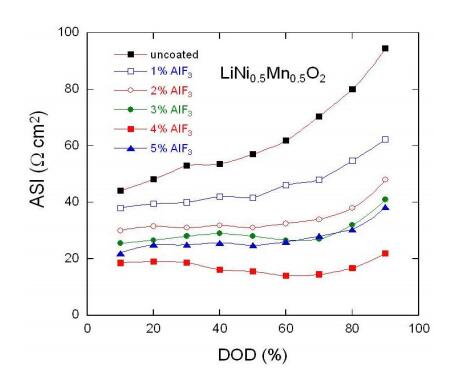
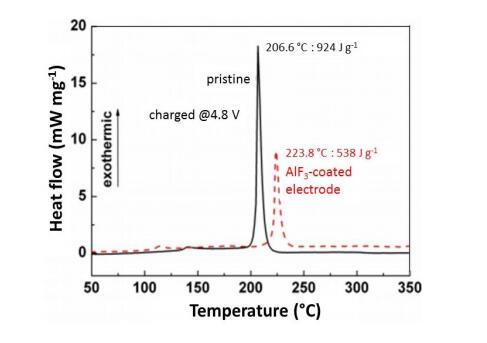
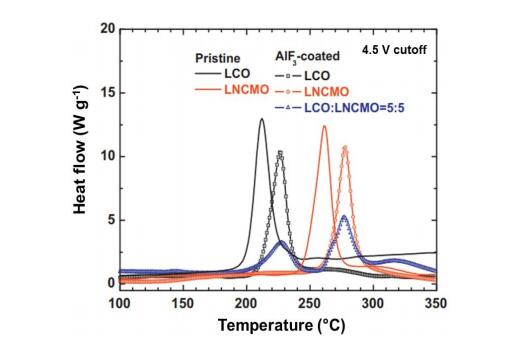


 DownLoad:
DownLoad: